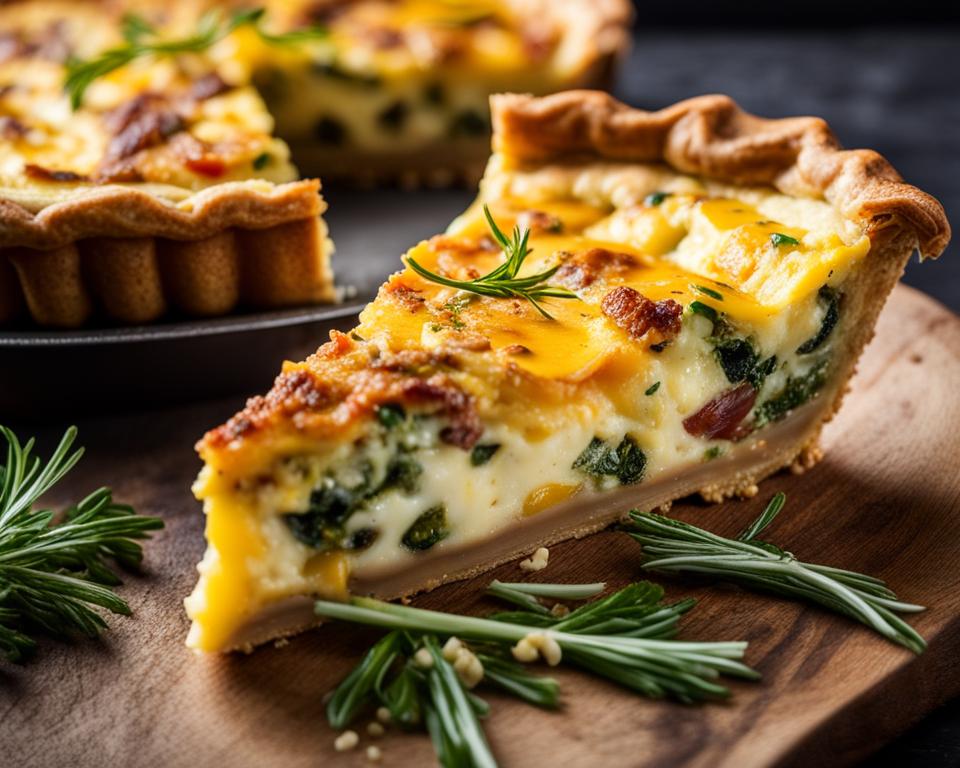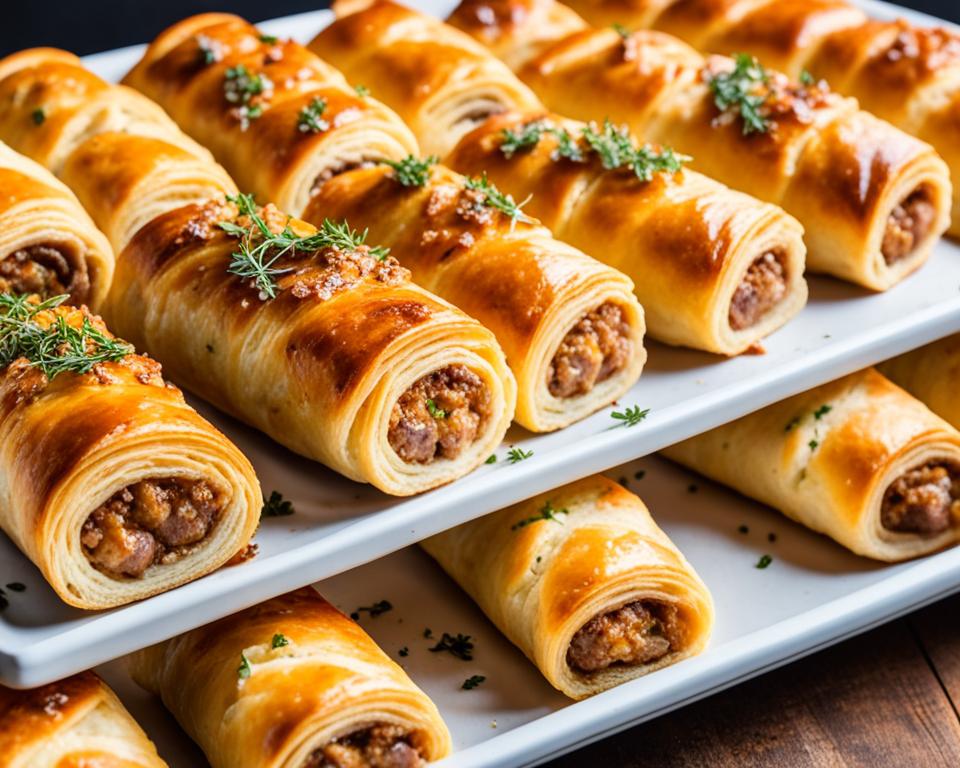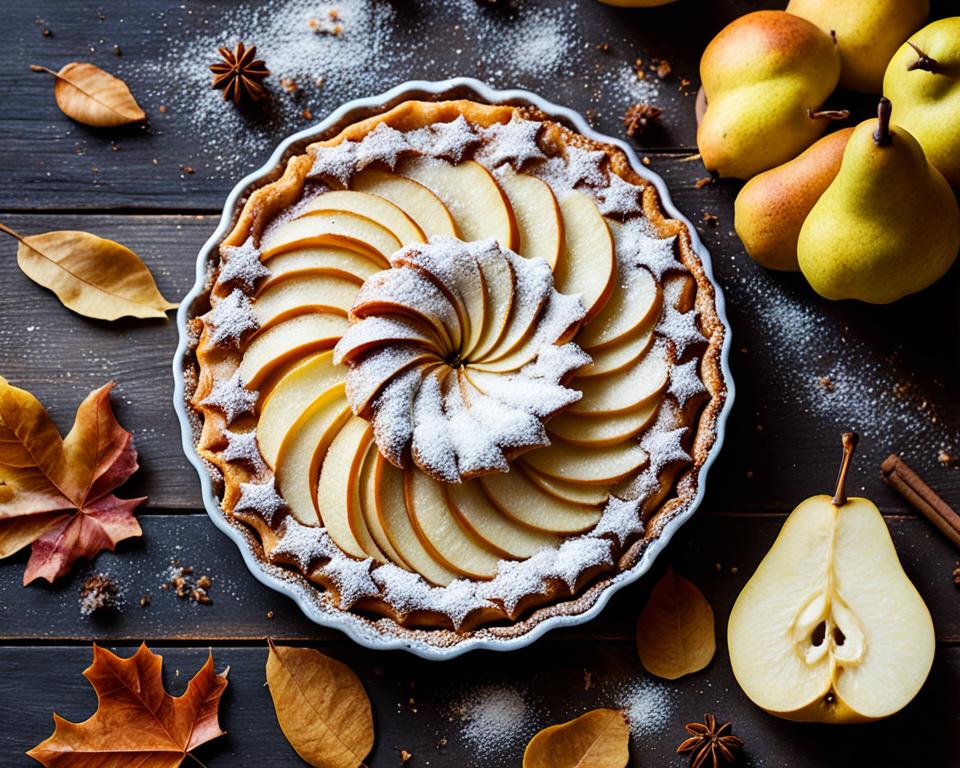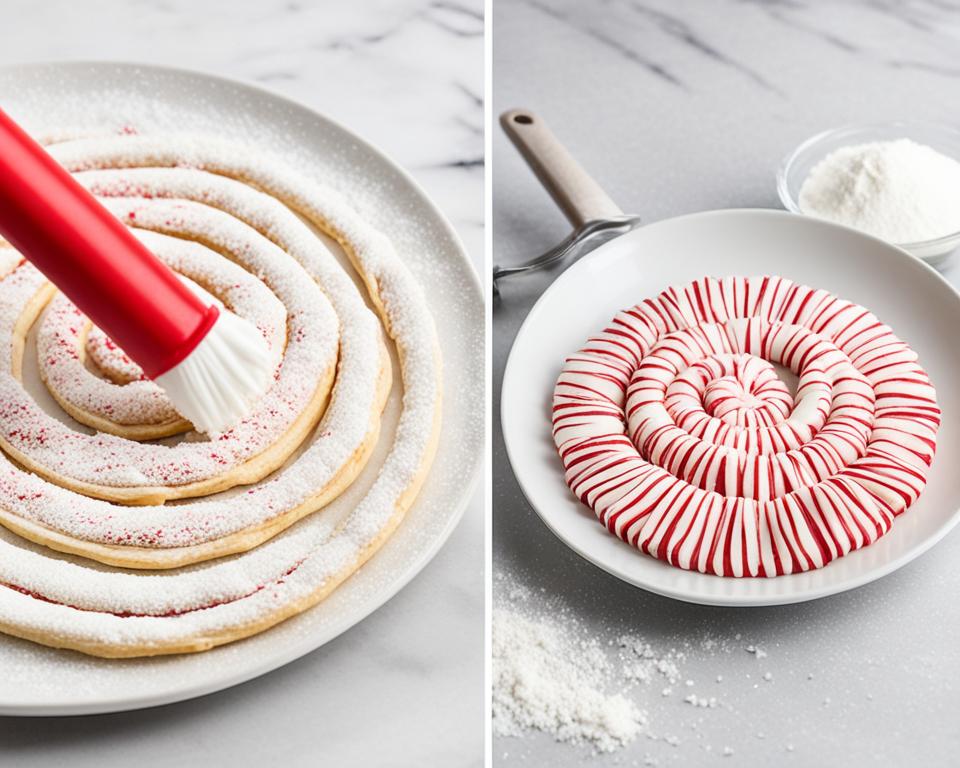Imagine the centerpiece of your next brunch gathering: a homemade quiche, radiating warmth and featuring layers of rich flavor and unforgettable texture. Every slice of this savory pie embodies a culinary craft where the buttery and distinctively flaky quiche crust embraces a creamy, savory custard teeming with choice ingredients like succulent bacon and gently caramelized onions. It’s an ensemble that promises not just to feed but to impress, making it not just another brunch recipe but an experience worth remembering.
Brunch enthusiasts will delight in the opportunity to cut through that first perfect, flaky layer and scoop up a serving of this breakfast dish, knowing that it’s as much a joy to gaze upon as it is to savor. Whether one is aiming to elevate a weekend breakfast or provide a bountiful feast for a midday meal, creating a homemade quiche stands out as the quintessential way to celebrate the simple pleasures of good food shared with good company.
Key Takeaways
- Flaky homemade crust forms the base of a brunch-worthy quiche.
- Savory fillings like cheese, bacon, and onions elevate the dish.
- Perfect as a breakfast dish or for any meal with friends and family.
- Quiche’s visual appeal enhances its status as a centerpiece at brunch gatherings.
- Customizable fillings offer versatility for all taste preferences.
- Ideal for entertaining, with options for make-ahead preparation.
Understanding the Appeal of a Flaky Quiche
The culinary acclaim of a flaky crust and creamy interior makes a delicious quiche an irresistible highlight of any brunch recipe anthology. This dish, with its warm and inviting presence, effortlessly graces brunch tables, promising a delightful gastronomic journey from the very first bite. A quiche’s allure is manifold, but it’s the interplay between the crust’s texture and the rich fillings that forms the true heart of its appeal.
Every chef and home cook aspires to achieve the quintessential quiche, balancing flavors and textures to create a dish that is both versatile and straightforward, an easy quiche recipe that never fails to enchant the palate and garner admiration.
The Texture That Wins Hearts: Butter and Flakiness
Imagine cutting into a golden, flaky crust – this is the moment of revelation for any quiche enthusiast. The outer layer crumbles just so, revealing a pillowy egg custard that is the soul of the quiche. The juxtaposition of the buttery crust against the smooth filling is what sets a quiche apart from any other egg-based dish. This textural dance, a result of meticulous baking science and culinary artistry, wins hearts effortlessly.
Serving a Crowd: Why Quiche is a Brunch Favorite
Consider the setting: a gathering of friends and family, an array of conversations and laughter, and in the center of it all, a delicious quiche waiting to be served. It is a dish that caters to versatility, capable of adapting to a variety of dietary preferences and flavor profiles. Quiche’s innate ability to serve a crowd comfortably, while making each guest feel individually catered to, fortifies its status as a staple in the array of brunch recipes. It represents both an act of love and a testament to the host’s finesse.
Origins of the Quiche: A Brief History
The journey of the savory pie known as quiche began in the medieval kingdoms that once sprawled across what is now northeastern France. As a treasured French tart, the quiche has matured through centuries into a versatile breakfast dish hailed for its comforting qualities and inviting flavor.
Quiche’s origins can be traced back to the German kingdom of Lothringen, which the French later renamed Lorraine. The name ‘quiche’ is derived from the German ‘kuchen’, meaning cake, which explains the quiche’s pastry-based foundation. This region gave birth to the now classic ‘Quiche Lorraine,’ establishing the quiche’s reputation as a delicious quiche enjoyed worldwide.
In its earliest forms, Quiche Lorraine was a simple savory pie, consisting of an open crust filled with a mixture of eggs and cream, flavored with smoked bacon. It wasn’t until later that cheese became an integral component of the quiche, enhancing its flavor complexity and texture. Over time, varieties expanded, turning the quiche into a canvas for culinary experimentation.
Unlike its egg-centric cousins, the omelet and the frittata, the quiche is distinguished by its creamy, tender consistency. Its delicate balance of eggs to dairy creates a less eggy and more subtle custard base. This base pairs impeccably with a myriad of possible fillings, from the traditional lardons or bacon to vegetables, seafood, and various cheeses.
Today, quiche sits comfortably at the crossroads of rustic and refined dining. It graces casual home brunches as effortlessly as it does elegant buffet spreads. Its culinary versatility and ease of personalization make it as much a reflection of the cook’s style as it is of the storied history of French cuisine.
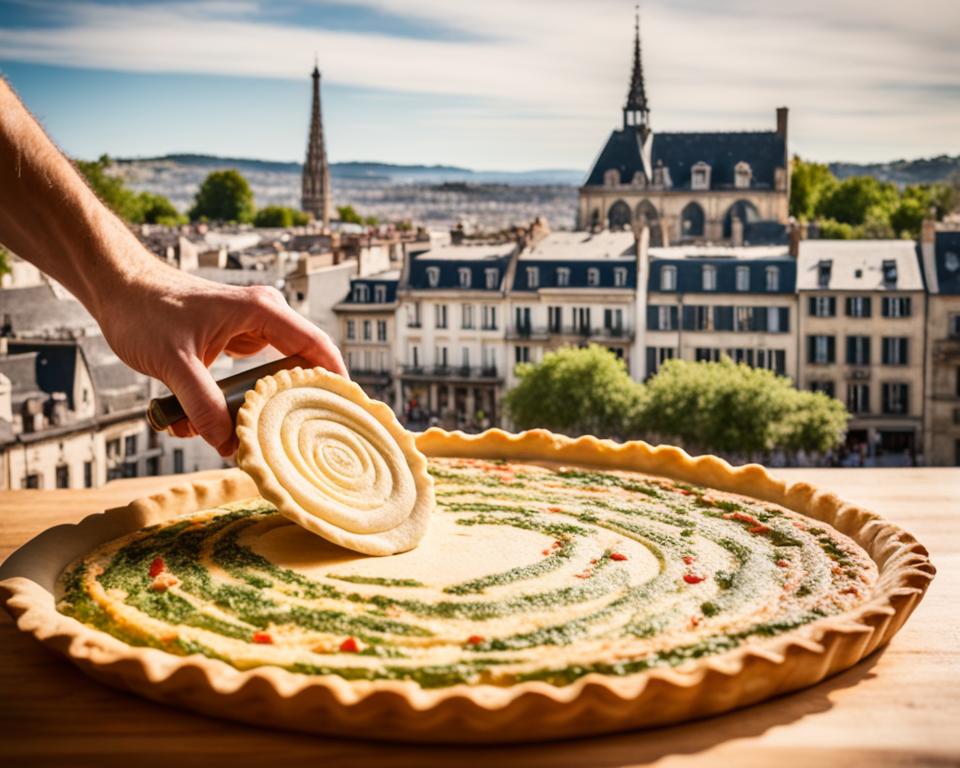
Savory pies like quiche tell stories of their own – stories of regions, traditions, and the people who have crafted and enjoyed them through generations. As a testament to quiche’s lasting appeal, its journey from a humble pie to an internationally-adored breakfast dish continues, symbolizing the French tart’s remarkable adaptability and timelessness.
Quiche embodies the true spirit of French culinary tradition, remaining an enduring favorite and a testament to its ability to adapt and evolve with changing tastes and ingredients.
- The quiche has its roots in German and French culinary history.
- Originally associated with the French region of Lorraine.
- The ‘Quiche Lorraine’ was simple, focusing on eggs and cream.
- Cheese was a later addition to the quiche formula.
- Now recognized as a flexible dish that allows for a variety of flavors.
Choosing the Right Ingredients for a Delicious Savory Pie
Embarking on the creation of a homemade quiche begins with a vigilant selection of ingredients that will form the foundation of the flaky crust and the sumptuous filling. A flawless savory pie is a ballet of textures and flavors — a union of a baked-to-perfection crust with a smooth, creamy center, lavished with the ideal mix of fillings. Here’s how to infuse every slice with harmonious taste and an invitation to indulge.
Create the Perfect Base: Pie Crust Essentials
At the heart of every savory pie is a flaky crust, a canvas that holds the potential of a cheesy quiche’s success. Achieving that buttery, fork-tender base starts with quality, cold unsalted butter — the pillar of a crisp, golden exterior. Alongside butter, the all-purpose flour must be precise to avoid a crust that’s too dense or crumbly. Just the correct measure, and a pinprick of paprika, will endow your pie crust with the irresistible flakiness and a hint of earthy warmth in color and taste.
Savvy bakers appreciate the crust as much more than an afterthought; it’s an essential component, integral to the symphony of textures that a savory pie provides. Consider the crust your first step towards culinary acclaim within your own kitchen.
Balancing Flavors: The Best Cheeses and Fillings
The choice of filling is where a cheesy quiche distinguishes itself — where a simple egg mixture transforms into a medley of savory delights. The richness of the filling comes from a full-bodied ensemble of whole milk and heavy cream, an interplay that delivers the ultimate creaminess a quiche deserves. Selecting the right cheese is a sacred task; an aged Gruyère offers a silky melt and nuanced depth, while a mature cheddar bestows a bolder, tangier taste that can hold its own against other ingredients.
| Ingredient | Role in Quiche | Tips for Selection |
|---|---|---|
| Butter | Flakiness in crust | Use unsalted and cold |
| Flour | Structure of crust | All-purpose; measure accurately |
| Paprika | Flavor and color | Pinch for subtlety |
| Whole Milk and Heavy Cream | Creaminess of filling | Combine for best texture |
| Aged Gruyère | Rich flavor | Silky texture, melts well |
| Mature Cheddar | Boldness in taste | Cheddar for sharper note |
As for the other stars of the filling, be they crispy bacon, sweet caramelized onions, or fresh spinach, these should be prepared thoughtfully. The key is balancing both moisture and robustness of flavor to prevent sogginess and to achieve taste distinction. In tandem with a flaky crust, the right filling will elevate your homemade quiche from mere sustenance into a coveted centerpiece, a savory pie that’s as memorable as it’s delectable.
Step-by-Step Guide to a Homemade Quiche
Creating an easy quiche recipe at home is both a gratifying and delicious venture. From the initial step of crafting the crust to the final moments of golden-brown perfection, there’s an intrinsic joy in preparing a homemade quiche. The process is simple and methodical, ensuring that even those new to the art of quiche-making can produce a savory pie that’s as delightful on the palate as it is on the eyes. Follow these essential steps to construct your own delicious quiche, destined to become the showstopper at your next meal.
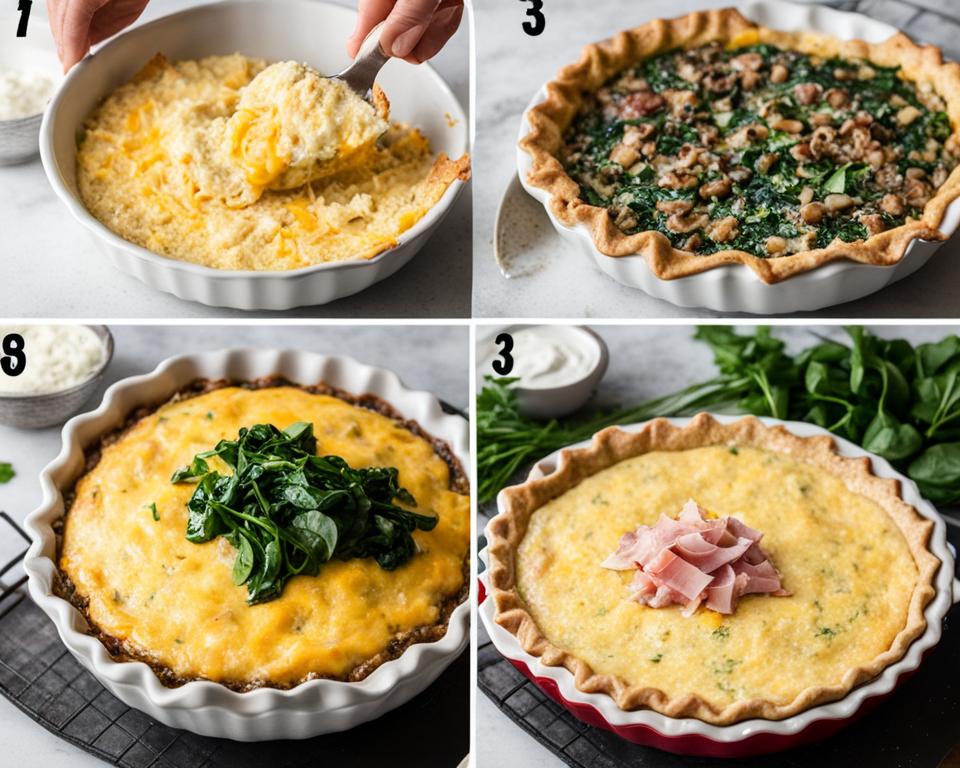
- Prepare the Quiche Crust: Begin by whisking together your dry ingredients—flour, salt, and a dash of paprika for a pop of flavor. Cut the cold, cubed butter into the mixture until pea-sized clumps form.
- Bind the Dough: Introduce a chilled egg and ice-cold water to coalesce the components into a cohesive dough. Shape into a disk, wrap, and place it in the refrigerator to chill.
- Roll and Shape: Once rested and firm, roll out your dough on a lightly floured surface and gently lay it into your pie dish, pressing into shape and crimping the edges for a decorative touch.
- Par-Bake the Crust: To ensure a crisp foundation, pre-bake your crust—use pie weights over parchment paper to keep it from bubbling or shrinking away from your dish.
- Prepare the Filling: Whisk the eggs until frothy before blending in the milk, cream, and seasonings for a creamy custard base. Fold in your choice of fillings such as crisp bacon, sweet onions, and grated cheese.
- Assemble and Bake: Spread your prepared fillings evenly into the crust, pour the custard mixture on top, and gently place your quiche into the oven to bake until the center is set and the top is golden.
- Rest Before Serving: After baking, allow your quiche to rest. This pause lets it settle into the perfect texture, marrying the flakiness of the crust with the creamy richness of the custard.
There you have the blueprint for a classic homemade quiche. Mastering this easy quiche recipe provides a starting point for countless variations, ensuring there’s always a new savory pie to delight in. Whether enjoyed fresh from the oven or served at room temperature, each slice is a testament to the care and skill poured into its creation. Now, it’s your turn to transform these steps into a heartwarming meal that will draw everyone to the table.
Secrets to a Perfectly Creamy Custard Filling
For many, the highlight of a delicious quiche is its creamy custard filling. Achieving this perfect harmony of creaminess within a flaky quiche crust requires not just the right ingredients but the precise technique. The foundation of the custard is eggs, brought to room temperature, setting the stage for a smooth emulsification that holds the quiche together.
Room-temperature eggs play a critical role in preventing a grainy texture and ensure an even blend with the dairy. Combining these eggs with a well-balanced mix of whole milk and heavy cream creates a filling that is luscious and velvety—a quintessential trait of a top-tier brunch recipe. But the magic doesn’t end there. The custard’s flavor is deepened with the addition of aromatic seasonings and exquisite aged cheese, bringing complexity and warmth to each bite.
Seasonings such as a delicate pinch of garlic powder, a dash of cayenne pepper for a hint of heat, and the irreplaceable salt and pepper culminate in a custard that’s undeniably flavorful. Yet, amidst these strong characters lies the subtle, yet distinct, role of the aged cheese. Aged Gruyère or sharp cheddar melts into the custard, creating a creamy custard that is not only inviting in taste but also in aroma and texture, establishing this delicious quiche as the star of your brunch recipe lineup.
| Ingredient | Contribution | Preparation Tip |
|---|---|---|
| Eggs | Base for custard | Bring to room temperature for even blending |
| Whole Milk & Heavy Cream | Velvety texture | Mix in equal parts for richness |
| Garlic Powder & Cayenne Pepper | Flavor depth | Adjust according to taste preference |
| Aged Cheese | Creaminess and flavor complexity | Grate and mix into the custard |
As the custard bakes within the flaky quiche shell, the ingredients bond together to form the soul-satisfying creamy texture synonymous with a superior delicious quiche. This intricate dance within the oven turns liquid ingredients to gold, resulting in a custard that is both robust and delicate, elegantly punctuating the flakiness of the quiche with every bite.
For those yearning to create the ultimate brunch recipe, the secret lies within these components and their careful orchestration, producing a creamy custard that’s the hallmark of the perfect quiche.
Flaky Quiche Crust Perfection: Tips and Techniques
Achieving that sought-after flaky crust for your homemade quiche involves more than just a recipe; it demands a dedication to craft. Understanding why and how your ingredients behave gives you the power to ensure your savory pie becomes the centerpiece of any table. Here, we embark on a culinary quest towards perfecting the quintessential element of any easy quiche recipe—the crust.
Keeping Ingredients Cold for Maximum Flakiness
One of the cardinal rules of pie dough preparation is temperature control. The key to that enviable flaky texture is maintaining cold ingredients throughout the process. But why? When bits of cold butter melt in the oven, they release steam, creating the flaky layers we crave. So, cube your butter and then put it back into the refrigerator to chill—or even the freezer, for brief spurts. Likewise, ensure that your water and egg are straight from the fridge before embarking on your crust-making journey.
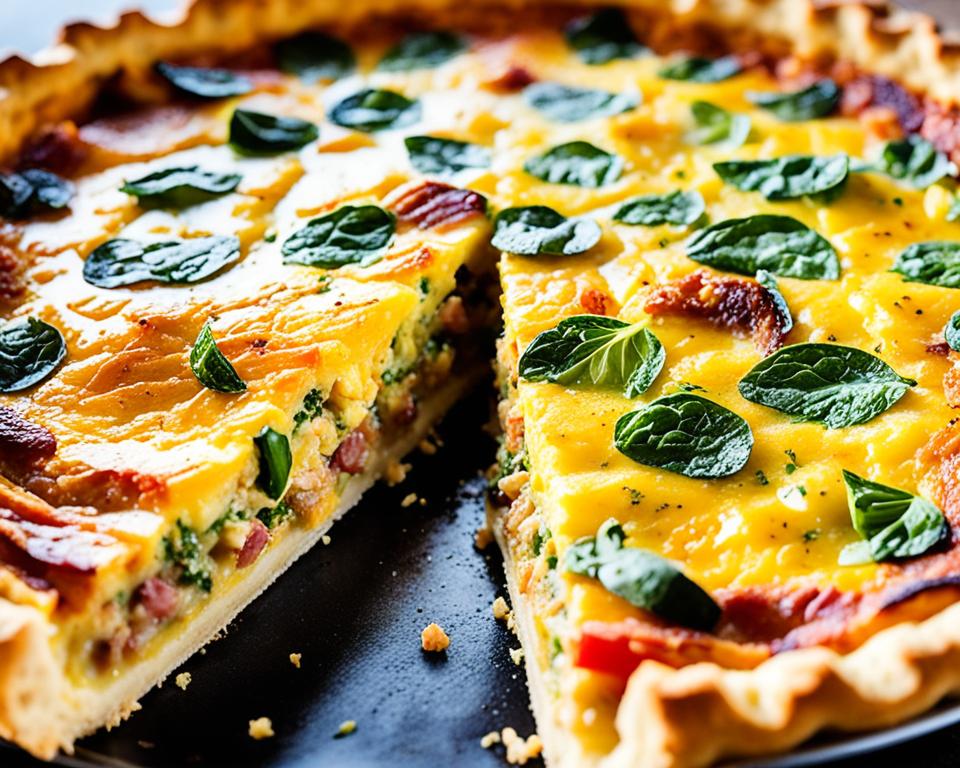
Rolling and Pre-Baking: Foundations for Success
Rolled too thinly or too thickly, your crust can be the foil of your homemade quiche effort. Aim for an even thickness that balances structural integrity and delicate flakiness. A gentle but firm rolling motion, working from the center outwards, ensures an even distribution of dough—and be conscious to not overwork it, lest you encourage gluten formation, which can lead to toughness.
Pre-baking, or blind-baking, is your next essential step. It may seem like an extra task, but this stage is your trusty ally against the evils of a soggy bottom. Lining your crust with parchment and filling it with pie weights or dried beans bakes it just enough to set the structure, so it’s ready and resilient when it meets the custardy embrace of your quiche filling.
With these tips and techniques in mind, your savory pie will be the archetype of a flaky crust, ready to be filled with whatever deliciousness your homemade quiche desires.
Variations on the Classic: Exploring Different Quiche Recipes
The versatility of a homemade quiche extends far beyond its basic form, allowing it to be a canvas for endless culinary creativity. Whether you’re craving the hearty flavors of a traditional Quiche Lorraine or inclined towards the verdant offerings of vegetables, there’s a quiche to suit every preference. These variations on the classic quiche not only preserve the essence of the dish but also introduce an array of flavors and textures, making each rendition a delightful exploration into the world of savory pies. As we delve into different quiche recipes, one thing remains consistent: the joy of slicing into a delicious quiche, whether it’s a beloved classic or a new creation that becomes a breakfast dish favorite.
Quiche Lorraine: A Timeless Classic
Quiche Lorraine is the quintessence of the quiche world, originating from the French region of Lorraine. With each bite, the palate experiences the rich, savory flavors of crumbled bacon melding seamlessly with the luxurious melt of Gruyère cheese. It’s this nostalgic fusion that crowns Quiche Lorraine as a beloved breakfast dish, and its enduring popularity at brunches stands as a testimony to its irresistible appeal.
Vegetarian Twists: Adding Greens and Veggies
For those seeking a greener option, vegetarian quiches enter the scene, boasting a bounty of nutrition and taste. Spinach, mushrooms, and asparagus offer more than just vibrant color; they enrich the quiche with flavor depth and versatility. These ingredients, encased in a flaky crust and embedded in a creamy custard, showcase that quiches can uphold their delicious quiche status even when laden with garden-fresh goodness. They’re the perfect way to transform the humble homemade quiche into a dish that celebrates the earth’s bounty, further solidifying its place as a savory pie to be savored.
- Quiche Lorraine: A savory pie rich with bacon and Gruyère
- Spinach and Goat Cheese Quiche: A vegetarian option with a kick of tangy cheese
- Ham and Swiss Quiche: Traditional ham paired with Swiss cheese for a comforting bite
- Crab Meat Quiche: A seafood indulgence with delicate crab meat for a luxurious twist
- Mushroom and Cheddar Quiche: Earthy mushrooms with sharp cheddar for depth in flavor
- Asparagus and Feta Quiche: Crisp asparagus and feta cheese for a fresh, seasonal savory pie
These variations of the classic quiche offer diners a chance to enjoy a well-loved dish with new twists that cater to their individual tastes. A homemade quiche, whether following the time-honored tradition of Quiche Lorraine or branching out into vegetarian realms, is a testament to the adaptability of this delicious quiche, truly making it a beloved dish for any breakfast, brunch, or meal of the day.
Pairing Your Quiche: Complementary Sides and Drinks
A delicious quiche may take center stage at any brunch, lunch, or dinner gathering, but it’s the supporting sides and drinks that enhance its rich profile. These complementary pairings ensure that your savory pie is not just a meal but a harmonized symphony of flavors. When planning your next brunch recipe, consider the interplay of tastes and textures to elevate the overall experience.
Classic brunch fare often incorporates a light, fresh element to offset the depth of a hearty breakfast dish. A simple side of glistening fresh fruit or a crisp green salad provides a refreshing contrast to the indulgent, buttery layers of a savory pie. These sides add a burst of color and a palate-cleansing tang that makes every forkful of quiche that much more satisfying.
| Side Dish | Purpose | Pairing Suggestions |
|---|---|---|
| Fresh Fruit | Lightness & Sweetness | Tropical fruits or a classic berry medley |
| Green Salad | Crunch & Freshness | Mixed greens with a vinaigrette dressing |
| Artisanal Breads | Texture & Substance | Fresh-baked sourdough or whole-grain bread |
When it comes to beverages, a delicious quiche can welcome a host of complementing options. Morning affairs may call for bright, citrusy drinks like Mimosas or a well-brewed cup of coffee to accompany a brunch recipe. The light bubbles and acidity cut through the richness of the quiche, providing a refreshing lift with each bite.
For later in the day, a glass of crisp white wine such as a light-bodied Chardonnay or a dry Sauvignon Blanc pairs beautifully with the complexity of a savory pie. These wines, with their subtle fruit notes and zesty finish, mirror the elegance and richness of a breakfast dish turned dinner centerpiece.
- A Mimosa’s effervescence complements the egg-based custard.
- Tea selections, from black to herbal, offer a warm, soothing pairing.
- Wine pairings can range from the dry to the aromatic, heightening the quiche’s flavor profile.
In crafting the ideal meal, it’s not just the main component but the thoughtful selection of sides and drinks that elevate a delicious quiche into a full, balanced suite of flavors. Each pairing should act as an accompaniment that contrasts or enhances, taking the entire dish to new gastronomic heights.
Make-Ahead Magic: Preparing Quiche for Easy Brunch Hosting
When it comes to hosting a delightful brunch, a homemade quiche embodies both elegance and ease. With its buttery flaky quiche crust and rich, savory filling, quiche is a brunch recipe that can be prepped and perfected in advance. This make-ahead approach ushers in seamless hospitality, allowing you to relish the company of your guests rather than bustling about in the kitchen.
Advance preparation is a cornerstone in the realm of easy quiche recipes. Given its forgiving nature, quiche accommodates the busiest of schedules. Imagine the convenience of crafting your pastry crust days prior, refrigerating or freezing it, all poised for its glorious transformation. Moreover, ingredients such as crispy bacon can be pre-cooked, and onions caramelized in advance, ensuring that every step unfolds with ease.
The flexibility of a homemade quiche extends to its assembly; the constructed quiche can comfortably inhabit your refrigerator, or even take a longer sojourn in the freezer. With this, you secure not just a sumptuous dish, but also the gift of time—a commodity so coveted in today’s fast-paced world. Below, find a simple guide to aid in your brunch preparations, ensuring that your quiche maintains its allure, from taste to texture, upon serving.
| Make-Ahead Component | Preparation Tips | Reheating Guidelines |
|---|---|---|
| Quiche Crust | Prepare and shape crust; refrigerate for up to 3 days or freeze up to 1 month. | If frozen, thaw in the fridge before filling and baking as usual. |
| Filling Ingredients | Cook bacon, caramelize onions, and shred cheese ahead of time. | Add directly to the custard mix before baking; adjust seasoning if needed. |
| Assembled Quiche | Can be fully assembled and stored in the fridge for 1 day or frozen. | Reheat in the oven at 350°F until heated through; typically 20-30 minutes. |
Embracing the make-ahead charm of quiches affords you the luxury of serenity on the day of your event. It elevates your easy quiche recipe into an art form, where time is no longer the enemy of taste. By following these simple steps, you ensure that each slice of your flaky quiche is as delectable and inviting as if it were made just moments before. Take pride as your quiche takes center stage, and bask in the joys of effortless entertaining.
Common Quiche Pitfalls and How to Avoid Them
Creating a delicious quiche is an art that home cooks aspire to master. When it comes to perfecting this savory pie, attention to detail is paramount. The typical concerns such as a soggy crust or an undercooked filling can turn a potentially easy quiche recipe into a daunting task. However, with a few precautionary steps, these common pitfalls can be easily avoided.
First and foremost, handling the flaky crust involves a technique known as par-baking. This process involves partially cooking the crust before adding the wet filling, thus ensuring that it maintains its flaky integrity once the quiche is fully baked.
Equally crucial is the temperature of the eggs used in the custard filling. For a smooth, cohesive custard that sets perfectly in the oven, bring your eggs to room temperature before whisking them into the mix.
Then, there’s the matter of the fillings. Knowing how to treat each filling can be the difference between success and a soggy bottom. Pre-cooking fillings like bacon, spinach, or onions is a must, as it reduces the moisture content that can otherwise compromise the texture of the custard.
Below is a table highlighting how to successfully navigate these common quiche-making challenges:
| Pitfall | Solution | Reasoning |
|---|---|---|
| Soggy Quiche Crust | Par-bake the crust | Setting the crust’s structure prevents it from becoming soggy. |
| Undercooked Filling | Use room temperature eggs and pre-cooked fillings | Ensures custard sets properly and evenly during baking. |
| Over-browning Crust | Use a pie crust shield | Protects crust edges from burning while the rest of the quiche cooks through. |
Lastly, vigilance during the baking process is key. Keep an eye on your quiche as it bakes, and be ready to make any necessary adjustments. This may include covering the edges with a pie crust shield or even a ring of aluminum foil to prevent over-browning.
A perfectly baked quiche is a harmony of texture and taste, where a delicious quiche is achieved by balancing a flaky crust with a well-set, savory filling.
Armed with these tips, even the novice cook can tackle a delicious quiche with confidence, and serve up a piece of culinary perfection that boasts a flaky crust, a savory and satisfying filling, all wrapped up in an easy quiche recipe.
Navigating Dietary Restrictions: Gluten-Free and Dairy-Free Options
When it comes to inclusive cooking, accommodating dietary restrictions ensures that everyone can savor the rich traditions of a savory pie. A gluten-free quiche no longer remains a distant dream but a delectable reality. By utilizing alternative flour blends or opting for a crustless variation, individuals with gluten sensitivities can enjoy the full experience of a well-crafted breakfast dish without the worry of adverse reactions. The artistry of making a quiche accessible does not end with the crust but extends to every ingredient choice.
Those who follow a dairy-free diet also yearn for the creamy, comforting texture that is synonymous with a traditional flaky quiche. The good news is, making a dairy-free quiche does not require a sacrifice in taste or texture. Non-dairy alternatives such as almond milk, soy cream, and vegan cheese present themselves as versatile substitutes, allowing for the classic culinary art of quiche-making to remain intact while being inclusive. Dairy-free options bring the same luxurious custard filling to the table, upholding the time-honored essence of this beloved breakfast dish.
Exploring these substitutions opens up a world of possibilities, enabling guests with gluten or dairy sensitivities to partake in the joy and community of a shared meal. Crafting a quiche that caters to various dietary needs does not mean a compromise on the end result—it’s about reimagining the approach to ensure that every guest can indulge in a slice of this quintessential savory pie. In doing so, the quiche retains its cherished role as a versatile and inclusive centerpiece for brunch, lunch, or dinner.
FAQ
What makes a quiche flaky and delicious?
The secret to a flaky and delicious quiche lies in the crust. It’s made with cold butter and sometimes a touch of paprika for flavor, which creates a buttery, flaky texture. The filling should be rich with a combination of whole milk, heavy cream, and cheeses like Gruyère or cheddar, along with tasty add-ins such as bacon or caramelized onions.
Can quiche serve as an appropriate dish for different meal times?
Absolutely, quiche is a versatile dish that can be served at brunch, lunch, and dinner. Its savory flavor profile and satisfying texture make it a delightful choice for any meal.
What distinguishes a quiche from other egg-based dishes?
Quiche is a French tart with a creamy, less eggy consistency than omelets or frittatas. Its rich custard filling and flaky pie crust set it apart, making it a sophisticated and versatile dish that can be filled with a variety of cheeses, meats, and vegetables.
How do you keep a quiche crust from getting soggy?
Preventing a soggy crust in quiche involves par-baking, or blind-baking, the crust before adding the wet filling. This pre-cooking step creates a firmer base for the custard.
What are some ideas for quiche fillings?
Quiche fillings can vary greatly depending on your preferences. Classic options include bacon, onion, and Gruyère cheese, as in a Quiche Lorraine. For a vegetarian option, spinach, mushrooms, and feta are delicious choices. Feel free to experiment with different combinations of meats, cheeses, and vegetables.
Can you make a quiche ahead of time?
Yes, quiche is an excellent dish to make ahead of time. You can prepare the dough and even bake the crust a day in advance. The filling can also be made ahead and refrigerated. Assemble and bake the quiche when you’re ready to serve. Quiche can also be fully baked, then cooled, refrigerated, or frozen, and reheated without losing its texture or flavor.
What are some good pairings with quiche for a complete meal?
Quiche pairs well with a variety of sides. For a brunch, consider fresh fruit or a green salad to balance the richness. For lunch or dinner, a simple vegetable side or a few slices of artisan bread could complement the meal nicely. As for drinks, a light-bodied Chardonnay or a crisp Mimosa are classic beverage choices.
How can you modify a quiche for gluten-free or dairy-free diets?
For a gluten-free diet, you can substitute the all-purpose flour with a gluten-free flour blend or even make a crustless quiche. For a dairy-free version, use non-dairy alternatives for milk and cream, and skip the cheese or opt for a vegan cheese substitute.
How do you know when a quiche is done baking?
A quiche is done when the filling is set and no longer jiggles when the pan is slightly shaken. The top should be golden brown. This typically takes about 35 to 45 minutes at 375°F (190°C), but always check your specific recipe for accurate timing.
What are the best cheeses to use in a quiche?
The best cheeses for quiche are ones that melt well and complement the other flavors in your filling. Aged Gruyère, mature cheddar, soft goat cheese, and creamy feta are all excellent choices, each adding a distinct taste to the final dish.

